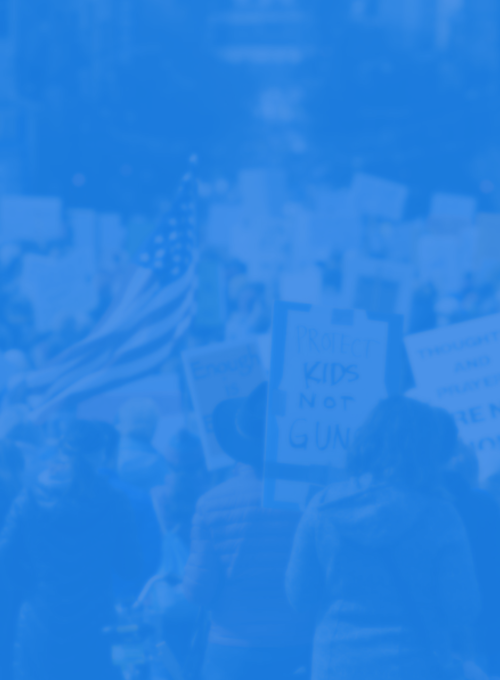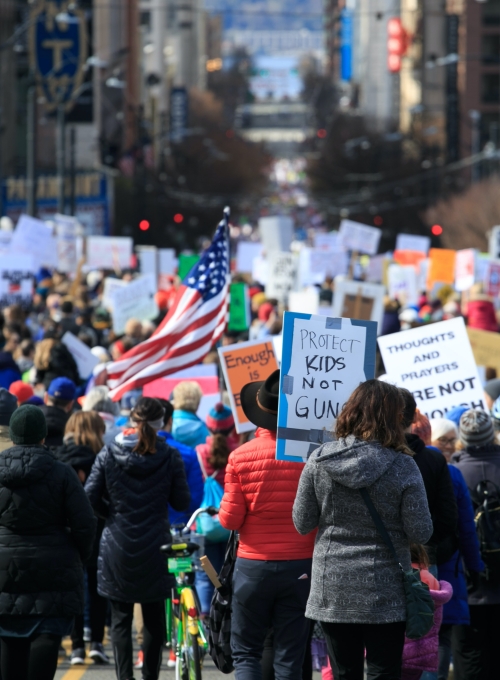
Advocacy
We use rigorous scientific research to advance and expand evidence-based policies and programs.
State-by-State DataSAFE STORAGE SAVES LIVESNational survey of gun policy
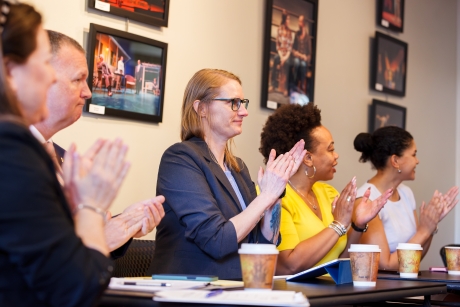
Center co-director Cass Crifasi, PhD '14, MPH, celebrates the signing of Delaware's Firearm Purchaser Licensing with Safer States initiative member Coalition for a Safer Delaware.
The Johns Hopkins Center for Gun Violence Solutions uses research to inform advocacy at the local, state, and federal levels. Our mission is to address gun violence as a public health emergency by conducting objective, rigorous research and driving effective solutions to save lives and promote health equity.
Our team uses all the tools of public health including research translation and communication, community engagement, legal and policy advocacy, implementation, training and technical assistance, and direct patient care to make research work in the real world.
Key Priorities
Our Center, which is comprised of research and advocacy experts, works to promote the following policy and programmatic priorities:
Supporting states to pass firearm purchaser licensing laws
also known as permit-to-purchase
Passing firearm removal laws
like extreme risk protection orders and domestic violence protection orders, and ensuring equitable and efficient implementation
Addressing community gun violence
through effective intervention programs
Prioritizing firearm suicide prevention
through behavior and policy change
Supporting strong public carry laws
including concealed carry and restricting gun possession in sensitive locations
Promoting safe firearm storage practices
through child access prevention laws
Increasing public funding
for gun violence prevention through research and offices of gun violence prevention
Preventing illegal gun trafficking
through policies that hold gun manufacturers and dealers accountable

Explore the latest gun violence data from your state & across the nation
Our Approach
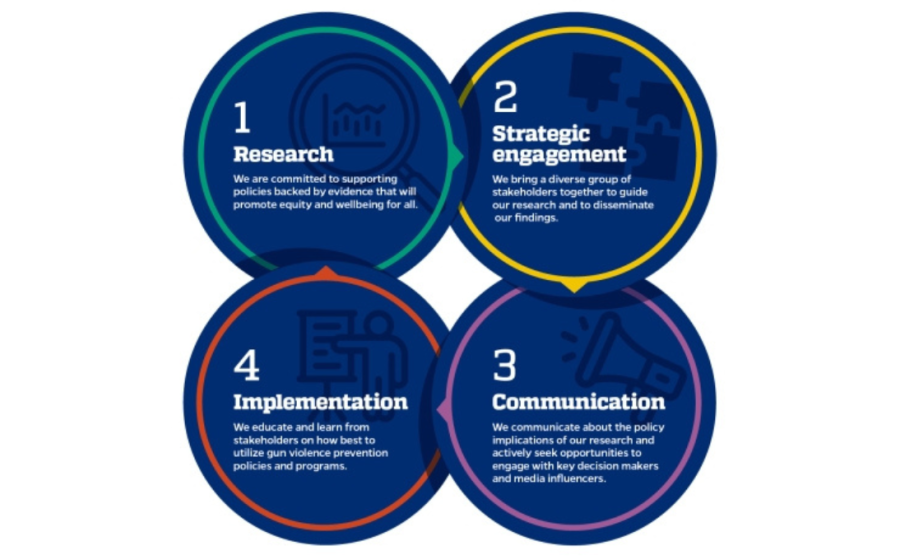
The Center for Gun Violence Solutions combines the expertise of highly respected gun violence researchers with the skills of deeply experienced gun violence prevention advocates. We use a public health approach to conduct rigorous scientific research to identify a range of innovative solutions to gun violence.
The Center takes a four-pronged approach to evidence and equity-informed advocacy. Our advocacy approach has helped advance gun violence prevention policies across the United States, including, among other things, firearm removal laws in California, an Office of Gun Violence Prevention in Colorado, and reporting for lost and stolen firearms in Virginia.
1. Research
Research is critical in public health and advocacy. The Center is committed to supporting policies backed by evidence that will promote safety and wellbeing for all. Our researchers are among the most respected in the field, and as such, data guides our advocacy agenda. In addition to research about effective policies, research in the advocacy context must also extend to analyze who has the power to make the policy change that we seek.
2. Strategic Engagement
Rarely is policy change accomplished by one individual or group. Bringing a diverse group of stakeholders together, bound by a common understanding of the problem and a mutually agreed upon solution, is a key component to successful advocacy campaigns. Strategic engagement is the process by which we build partnerships to support a common goal. We bring academics and community partners in impacted communities together to build a collective agenda. The Center strongly believes that we are more effective advocates when we understand and incorporate a wide variety of perspectives.
3. Communication
The Center is committed to supporting policies backed by evidence that will promote safety and wellbeing for all. Though we are part of an academic institution, we do not shy away from communications about the policy implications of our research, and actively seek opportunities to engage with key decision makers and media influencers. Additionally, we seek to use communications to build support for solutions among the general public. We utilize a myriad of communication channels at our disposal and fully engage in the ever changing world of social media in order to ensure connection to a wide audience.
4. Implementation
Laws do not implement themselves. Passing a law or creating a new program is not where the work ends—it’s where it really begins. Unless stakeholders know about the law and are prepared to use it, the benefits will not materialize. Our advocacy continues into the implementation phase, where we educate and train stakeholders how to use what we've created. For instance, we helped pass Extreme Risk Protection Order laws in almost 20 states and then worked to educate law enforcement, medical and public health professionals, and violence prevention advocates on how to use the new law.

Find State-Specific Resources
Safer States Initiative
The Safer States Initiative is equipping gun violence prevention leaders in states and communities across the country with the policy expertise and capacity they need to continue to create change.
The organizations included in our Safer States Initiative network — all statewide organizations committed to preventing gun violence in their home communities — use education, advocacy, and community engagement to pursue meaningful change in their states. They envision their states free from the burden of gun violence in all its forms, including mass shootings, community violence, suicide by firearm, domestic violence, and more.
Safer States Initiative member organizations engage relevant stakeholders to reduce rates of gun violence and build safer, more connected communities. The Safer State Initiative network believes that we have the power and the responsibility to do all that we can to reduce gun violence in our homes, in our classrooms, on our streets, and throughout the states where we live, learn, work, and play.
The Center understands the importance of state policy change and the need to support local advocacy organizations. While limited movement has occurred on the federal level, state and local organizations have secured some of the most important victories, saving lives in communities across the country. Even after great successes with few resources, many state and community gun violence prevention leaders and organizations continue to face barriers.
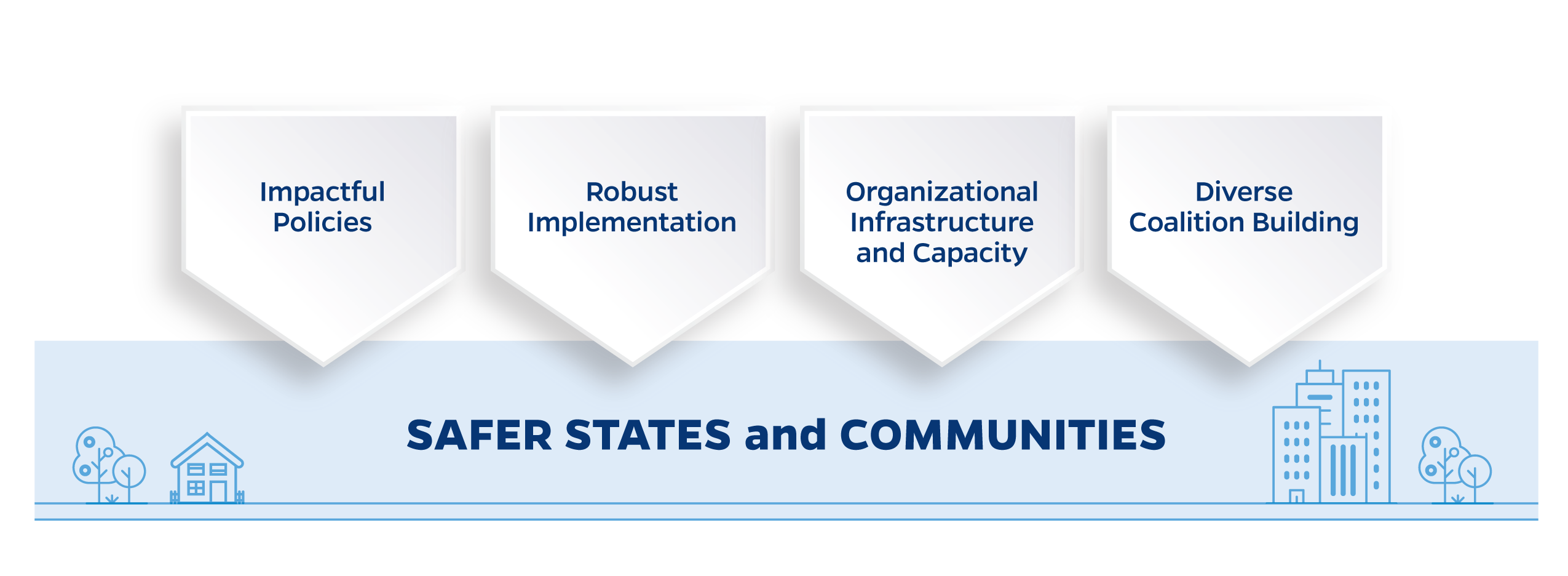
Successes
The Safer States Initiative network is made up of community organizations across the country such as New Mexicans to Prevent Gun Violence (NMPGV). NMPGV is several thousand members strong and has deep relationships with local schools, school boards, cities, counties, police departments, interfaith groups, and local and national organizations, all focused on identifying and taking action on opportunities to reduce gun violence in New Mexico.
NMPGV has published a Gun Violence Prevention Toolkit that serves as a step-by-step guide for advocates looking to bring the gun violence prevention movement to their local communities. Highlighting some of their most successful programs such as Guns to Gardens and Murals to End Gun Violence, the toolkit features resources to help conduct public outreach, promote gun safety, facilitate gun buy-back programs, connect with youth, use creative mediums for storytelling, and engage in legislative solutions.
By connecting state and community leaders who already possess the local expertise and deep relationships with partners and policy makers with the most up-to-date research and data we help build partnerships, elevate the people most directly impacted by gun violence, and create safer states and communities through life-saving policies and laws.
“The investment and expertise from the Safer States Initiative has helped us expand our impact as a leader in this issue in Delaware, and nationally. We received crucial, highly informed guidance on a variety of issues, including evidence-informed policy, data collection, and programming.”
— Traci Murphy, Delaware Coalition Against Gun Violence
Most Americans Support Our Priority Solutions.
82%
support removing guns during a DVPO.
72%
support firearm purchaser licensing laws.
77%
support family-initiated ERPO.
74%
support requiring someone to lock up their guns when not in use.
Public Opinion Polling
The Center utilizes public opinion polling and other research to better understand trends in gun ownership, attitudes towards firearms carrying, and other issues related to guns and gun violence in the United States. Public opinion polling helps to inform advocacy and the polling results can help show lawmakers that the majority of Americans, including gun owners, support various evidence-informed gun violence prevention policies. See the results from the latest Johns Hopkins National Survey of Gun Policy.
Johns Hopkins researchers have tracked Americans’ support through the Johns Hopkins National Survey of Gun Policy, administering the survey every two years since 2013. The results from these surveys indicate broad support for many gun violence prevention policies among both non-gun owners and gun owners, and across political affiliation and geographic regions. Trends over time suggest growing national support for a number of policies to reduce the toll of gun violence in the U.S.
The Center Resources
